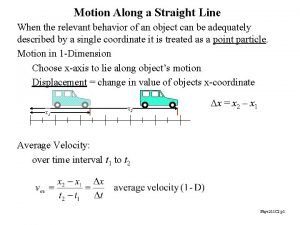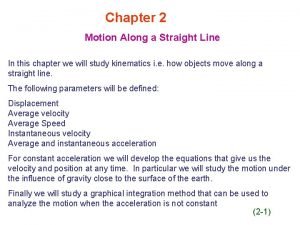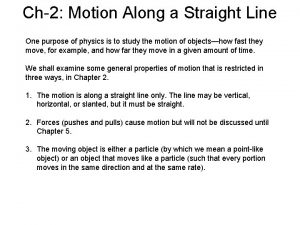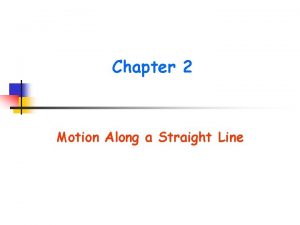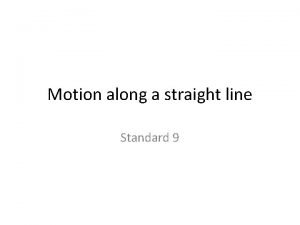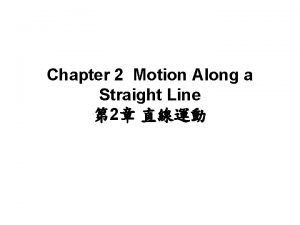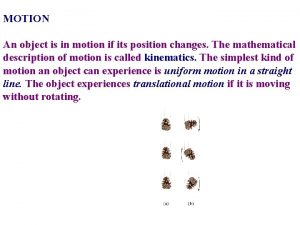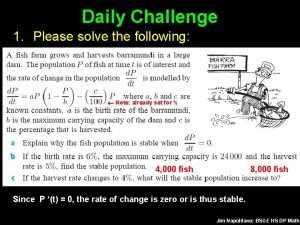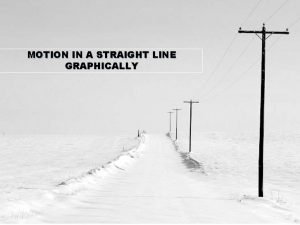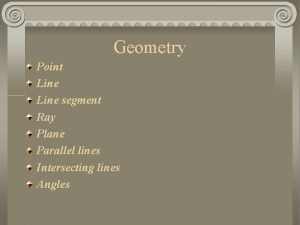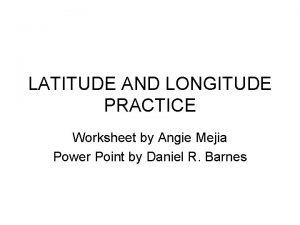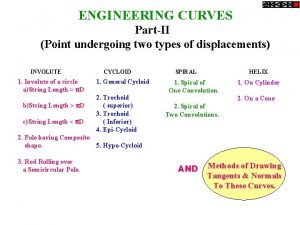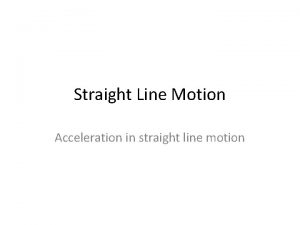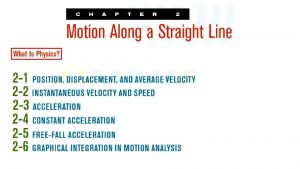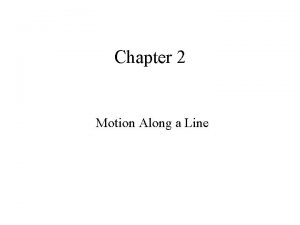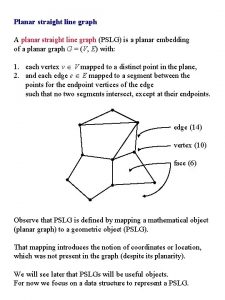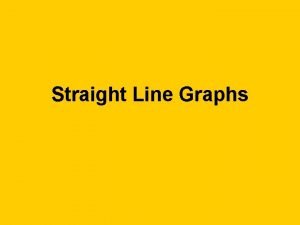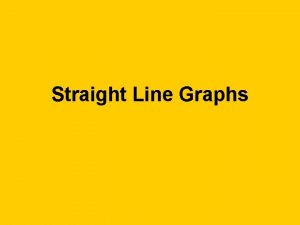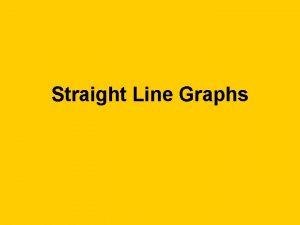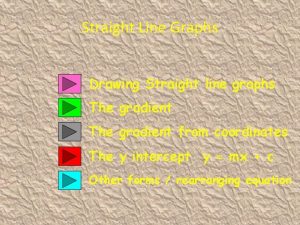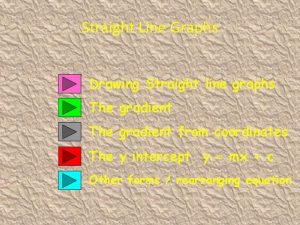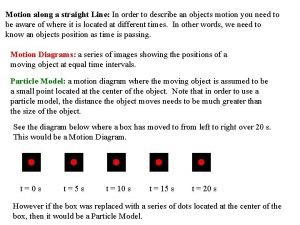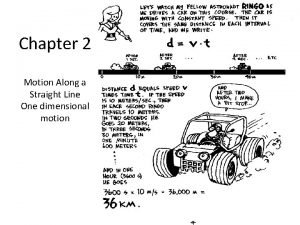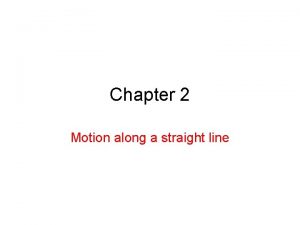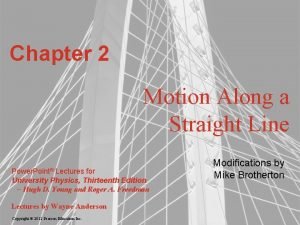Motion Along a Straight Line When the relevant















- Slides: 15

Motion Along a Straight Line When the relevant behavior of an object can be adequately described by a single coordinate it is treated as a point particle. Motion in 1 -Dimension Choose x-axis to lie along object’s motion Displacement = change in value of objects x-coordinate x 1 x 2 Dx = x 2 – x 1 Average Velocity: over time interval t 1 to t 2 Phys 211 C 2 p 1

Instantaneous Velocity Rate at which displacement changes with time http: //phys 23 p. sl. psu. edu/simulations/1 d_motion. ip slope of graph of x versus t. generally not equal to instantaneous velocity. +/- slope for +/- velocity (direction!) motion away from/towards the origin Phys 211 C 2 p 2

Average acceleration A change in the (instantaneous) velocity with time acceleration is not the same as velocity! Instantaneous acceleration Rate at which velocity changes with time Phys 211 C 2 p 3

What can be said about displacement, velocity and acceleration at and between t 1 and t 2? x-t graph x t t 1 t 2 Phys 211 C 2 p 4

What can be said about displacement, velocity and acceleration at and between t 1 and t 2? v-t graph v t t 1 t 2 Phys 211 C 2 p 5

Motion with constant acceleration a simplified model for many useful situations a = aav a = constant means v-t graph is a straight line with the conventions: velocity is v at time t, velocity is v 0 at time 0 : Phys 211 C 2 p 6

Velocity and Acceleration final velocity = initial velocity + change in velocity v v at v 0 v t v v 0 t v at v 0 at t v v 0 at v Phys 211 C 2 p 7

constant acceleration a with the conventions: position is x, velocity is v at time t, position is x 0, velocity is v 0 at time 0 : Phys 211 C 2 p 8

One final useful relation, take Phys 211 C 2 p 9

Summary: For a particular problem, use an equation which only has one unknown Phys 211 C 2 p 10

Example 2 -4 A motorcyclist heading east is 5. 00 m past the city limits sign (taken to be the origin) at a speed of 15. 0 m/s. His acceleration is 4. 00 m/s 2. Find his position and velocity 2. 00 s later. Where is the motorcycle when his velocity is 25. 0 m/s. First identify known quantities, then identify appropriate equation to solve for desired unknown. Phys 211 C 2 p 11

Example 2 -5 A motorist traveling with a constant velocity of 14 m/s (about 34 mph) passes a school crossing, where the speed limit is 15 mph. Just as the motorist passes, a police officer on a motorcycle waiting at the crossing accelerates at a rate of 3. 00 m/s 2 in hot pursuit of the motorist. How much time elapses before the officer catches up with the motorist? What is the officer’s speed at this point? How far beyond the crossing are the vehicles at this point? Phys 211 C 2 p 12

Free fall: under the influence of gravity Aristotle’s vs Galileo’s picture of motion acceleration due to gravity (on the surface of the Earth) air resistance can be ignored acceleration is downward if positive direction is taken to be upward, a = -g Phys 211 C 2 p 13

Example 2 -6 An object is dropped from the top of a very tall building. How far has it dropped and how fast is it moving after 1. 00 s? 2. 00 s? 3. 00 s? Phys 211 C 2 p 14

Example 2 -7, 8 An object is thrown straight upward with a speed of 15. 0 m/s from the roof of a very tall building. On the way down, it just misses the railing. Find the position and velocity of the object 1. 00 and 4. 00 seconds after being thrown. Find the velocity when the object is 5. 00 m above the railing. Determine the maximum height reached, and the time at which it is reached. The acceleration of the object when it is at its maximum height. At what time is the object 5. 00 m below the railing? Phys 211 C 2 p 15
 Motion along a straight line definition
Motion along a straight line definition Motion along a line
Motion along a line It is the motion along a straight line
It is the motion along a straight line It is a motion along a straight line
It is a motion along a straight line Motion along a straight line formulas
Motion along a straight line formulas Constant-acceleration equations
Constant-acceleration equations Chapter 2 motion along a straight line
Chapter 2 motion along a straight line An object travels back and forth along a straight line
An object travels back and forth along a straight line Dt
Dt Straight line motion revisited homework
Straight line motion revisited homework Straight line motion equations
Straight line motion equations Collection of points along a straight path
Collection of points along a straight path Eg subject code
Eg subject code Latitudes and longitudes worksheet
Latitudes and longitudes worksheet Construct a helix with radius 40mm
Construct a helix with radius 40mm Fold back the paper along the dotted line
Fold back the paper along the dotted line
